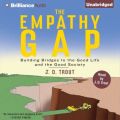 The Empath
The Empath
Автор: Bonnie Vanak
Год издания: 0000
Every werewolf needs a mate… Nicolas was the strongest and fiercest of the Draicon, until he was banished. Now the werewolf has only one path to redemption: find the Draicon’s long-lost empath, the woman who will save the pack – and Nicolas himself – from terrible danger. Maggie is a vet, dedicated to healing.She has no idea of her true nature, the magic waiting in her soul – or the man coming to claim her. The survival of their pack depends on them finding each other, on their ability to become one. But their enemies have also found Maggie and will kill to stop her surrendering to an all-consuming passion…
 Empathic Space. The Computation of Human-Centric Architecture
Empathic Space. The Computation of Human-Centric Architecture
Автор: Christian Derix
Год издания:
In recent years, questions of space have gained renewed momentum in architecture and urban design, as adaptation, densification and sustainable regeneration have become an increasing priority. While most computing-based design tends to emphasise the formal aspects of architecture, overlooking space and its users, the ‘original’ computational design approaches first spearheaded in the UK in the 1960s and 1970s tended to be focused on behavioural and occupational patterns. Over the last decade, a new generation of design research has emerged that has started to implement and validate previous investigations into spatial computation, aiming to understand how to design spatial configurations based on user experiences. This revives an interest in the experiential that was first explored in the early 20th century by German and Nordic organic architects, who invented design methods that correlated cognitive responses of buildings' occupants to spatial structure. The current revival of human-centric design, however, represents the first design approach that synthesises spatial design and algorithmic techniques with organic design thinking, which could also be regarded as a return to the ‘first principles' of architectural design. Contributors include: Paul Coates, Christian Derix, Olafur Eliasson, Lucy Helme, Bill Hillier, Asmund Izaki, Prarthana Jagannath, Dan Montello, Juhani Pallasmaa, Philip Steadman and Guy Theraulaz. Featured Architects/Designers: Jussi Angesleva (Art+Com), Stan Allen, Aedas|R&D, Markus Braach (Kaisersrot), Hermann Hertzberger, Kazuhiro Kojima (Cat), Pablo Miranda and Rafi Segal.
 Empathy Gap
Empathy Gap
Автор: J. D. Trout
Год издания:
 Finding the Lost Art of Empathy
Finding the Lost Art of Empathy
Автор: Tracy Wilde
Год издания:
 Empathy and Fairness
Empathy and Fairness
Автор: Gregory Bock R.
Год издания:
Empathy is the process that allows us to share the feelings and emotions of others, in the absence of any direct emotional stimulation to the self. Humans can feel empathy for other people in a wide array of contexts: for basic emotions and sensation such as anger, fear, sadness, joy, pain and lust as well as for more complex emotions such as guilt, embarrassment and love. It has been proposed that, for most people, empathy is the process that prevents us doing harm to others. Although empathy seems to be an automatic response of the brain to others’ emotional reactions, there are circumstances under which we do not share the same feeling as others. Imagine, for example, that someone who does the same job as you is paid twice as much. In this case, that person might be very satisfied with their extra salary, but you would not share this satisfaction. This case illustrates the ubiquitous feeling of fairness and justice. Our sense of fairness has also become the focus of modern economic theories. In contrast to the prominent self-interest hypothesis of classic economy assuming that all people are exclusively motivated by their self-interest, humans are also strongly motivated by other-regarding preferences such as the concern for fairness and reciprocity. The notion of fairness is not only crucial in personal interaction with others in the context of families, workplace or interactions with strangers, but also guides people’s behaviour in impersonal economic and political domains. This book brings together work from a wide range of disciplines to explain processes underlying empathy and fairness. The expert contributors approach the topic of empathy and fairness from different viewpoints, namely those of social cognitive neuroscience, developmental psychology, evolutionary anthropology, economics and neuropathology. The result is an interdisciplinary and unitary framework focused on the neuronal, developmental, evolutionary and psychological basis of empathy and fairness. With its extensive discussions and the high calibre of the participants, this important new book is essential reading for anyone with an interest in this topic.